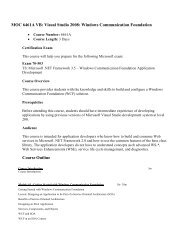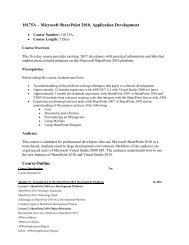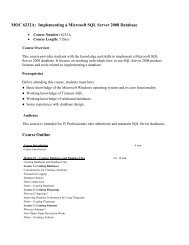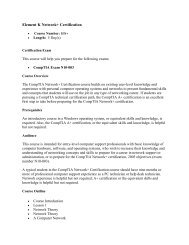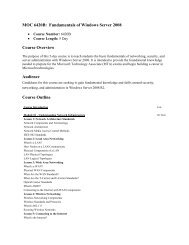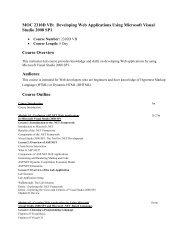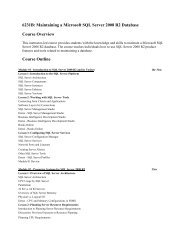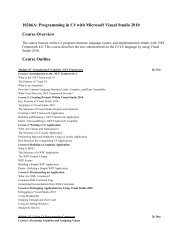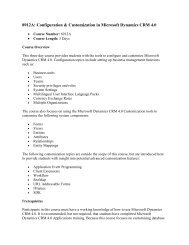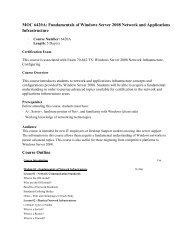MOC 2310D CS: Developing Web Applications Using Microsoft ...
MOC 2310D CS: Developing Web Applications Using Microsoft ...
MOC 2310D CS: Developing Web Applications Using Microsoft ...
Create successful ePaper yourself
Turn your PDF publications into a flip-book with our unique Google optimized e-Paper software.
<strong>MOC</strong> <strong>2310D</strong> <strong>CS</strong>: <strong>Developing</strong> <strong>Web</strong> <strong>Applications</strong> <strong>Using</strong> <strong>Microsoft</strong> Visual<br />
Studio 2008 SP1<br />
Course Number: <strong>2310D</strong> <strong>CS</strong><br />
Course Length: 5 Day<br />
Course Overview<br />
This instructor-led course provides knowledge and skills on developing <strong>Web</strong> applications by using<br />
<strong>Microsoft</strong> Visual Studio 2008 SP1.<br />
Audience<br />
This course is intended for <strong>Web</strong> developers who are beginners and have knowledge of Hypertext Markup<br />
Language (HTML) or Dynamic HTML (DHTML).<br />
Course Outline<br />
Course Introduction 3m<br />
Course Introduction<br />
Module 01 - Exploring ASP.NET <strong>Web</strong> <strong>Applications</strong> 1h 37m<br />
in <strong>Microsoft</strong> Visual Studio 2008 SP1<br />
Lesson 1: Introduction to the .NET Framework<br />
Introduction to <strong>Microsoft</strong> .NET<br />
Benefits of the .NET Framework<br />
Components of the .NET Framework<br />
Visual Studio 2008 SP1: The Tool for .NET Development<br />
Lesson 2: Overview of ASP.NET<br />
Client-Server Interaction<br />
What Is ASP.NET?<br />
Components of ASP.NET <strong>Web</strong> <strong>Applications</strong><br />
Generating and Rendering Markup and Code<br />
ASP.NET Dynamic Compilation Execution Model<br />
ASP.NET Extensions<br />
Lesson 3: Overview of the Lab Application<br />
Lab Scenario<br />
Lab Application Setup<br />
Walkthrough: The Lab Solution<br />
Demo - Exploring the .NET Framework<br />
Demo - Exploring the Views and Controls of Visual Studio 2008 SP1<br />
Module 01 Review<br />
Module 02 - Creating <strong>Web</strong> <strong>Applications</strong> by <strong>Using</strong> <strong>Microsoft</strong> 1h 4m<br />
Visual Studio 2008 SP1 and <strong>Microsoft</strong> .NET–Based Languages<br />
Lesson 1: Choosing a Programming Language<br />
Features of Visual Basic<br />
Features of Visual <strong>CS</strong><br />
Scenarios for Mixed-Language Environments
Considerations for Choosing Between Visual Basic and Visual <strong>CS</strong> for an Application<br />
Lesson 2: Overview of Visual Studio 2008 SP1<br />
Advantages of <strong>Using</strong> Visual Studio 2008 SP1<br />
Available Project Templates<br />
Features of the Integrated Development Environment<br />
Visual Studio 2008 SP1 Start Page<br />
Lesson 3: Creating a Simple <strong>Web</strong> Application<br />
<strong>Web</strong> Application Development Process<br />
<strong>Web</strong> Application Project Files and Folders<br />
<strong>Web</strong> Site Project Files and Folders<br />
Choosing Between a <strong>Web</strong> Site and a <strong>Web</strong> Application Project<br />
<strong>Web</strong> Application Files<br />
Demo - How To Create a Simple <strong>Web</strong> Application Project<br />
Deploying a <strong>Web</strong> Application<br />
Module 02 Review<br />
Module 03 - Creating a <strong>Microsoft</strong> ASP.NET <strong>Web</strong> Form 50m<br />
Lesson 1: Creating <strong>Web</strong> Forms<br />
What Is a <strong>Web</strong> Form?<br />
How To Create a <strong>Web</strong> Form<br />
Demo - How To Create a <strong>Web</strong> Form<br />
Lesson 2: Adding and Configuring Server Controls in a <strong>Web</strong> Form<br />
What Is a Server Control?<br />
Types of Server Controls<br />
Saving View State<br />
Adding and Configuring HTML Server Controls<br />
Adding and Configuring <strong>Web</strong> Server Controls<br />
Discussion: Selecting the Appropriate Server Control<br />
Module 03 Review<br />
Module 04 - Adding Functionality to a <strong>Microsoft</strong> ASP.NET <strong>Web</strong> Form 1h 20m<br />
Lesson 1: Working with Code-Behind Files<br />
Methods for Implementing Code<br />
Mixed Code and Inline Code<br />
Code-Behind Files<br />
<strong>Using</strong> Code-Behind Files<br />
Lesson 2: Handling Server Control Events<br />
What Are Event Handlers?<br />
What Are Client-Side Event Handlers?<br />
What Are Server-Side Event Handlers?<br />
How Client-Side and Server-Side Event Handlers Are Processed<br />
Creating Server-Side Event Handlers<br />
Demo - How To Create Server-Side Event Handlers<br />
Working with <strong>Web</strong> Server Controls by <strong>Using</strong> Event Handlers<br />
Lesson 3: Creating Classes and Components by <strong>Using</strong> Visual Studio 2008 SP1<br />
What Are Types, Components, and Classes?<br />
Creating a Component<br />
Demo - How To Create a Class in Visual Studio 2008 SP1<br />
Adding Member Variables and Constants to a Class
Adding Properties and Methods to a Class<br />
Adding Class Constructors<br />
Accessing Components in an ASP.NET <strong>Web</strong> Form<br />
Lesson 4: Handling Page Events<br />
Page Event Life Cycle<br />
The PostBack Process<br />
Handling Postbacks<br />
Demo - How To Handle Page Events<br />
Module 04 Review<br />
Module 05 - Implementing Master Pages and User Controls 24m<br />
Lesson 1: Creating Master Pages<br />
What Are Master Pages?<br />
Creating a Master Page<br />
What Are Content Pages?<br />
Creating a Content Page<br />
What Are Nested Master Pages?<br />
Runtime Behavior of Master Pages<br />
Adding a Master Page to an Existing <strong>Web</strong> Application Project<br />
Discussion: Advantages of Master Pages<br />
Lesson 2: Adding User Controls to an ASP.NET <strong>Web</strong> Form<br />
What Are User Controls?<br />
Advantages and Disadvantages of <strong>Using</strong> User Controls<br />
Converting a <strong>Web</strong> Form to a User Control<br />
Demo - How To Convert a <strong>Web</strong> Form into a User Control<br />
Adding a User Control to a <strong>Web</strong> Form<br />
Module 05 Review<br />
Module 06 - Validating User Input 48m<br />
Lesson 1: Overview of User Input Validation<br />
What Is Input Validation?<br />
Client-Side and Server-Side Validation<br />
Lesson 2: ASP.NET Validation Controls<br />
Overview of ASP.NET Validation Controls<br />
Basic ASP.NET Validation Controls<br />
RegularExpressionValidator Control<br />
CustomValidator Control<br />
Combining Validation Controls<br />
Adding Validation Controls to a <strong>Web</strong> Form<br />
Positioning and Configuring Validation Controls on a <strong>Web</strong> Form<br />
Lesson 3: Validating <strong>Web</strong> Forms<br />
Adding the ValidationSummary Control<br />
Programmatically Validating <strong>Web</strong> Forms<br />
Demo - Programmatically Validating<br />
Module 06 Review<br />
Module 07 - Debugging <strong>Microsoft</strong> ASP.NET <strong>Web</strong> <strong>Applications</strong> 40m<br />
Lesson 1: Debugging in ASP.NET<br />
Discussion: Types of Errors<br />
What Is Debugging?
Debug Class<br />
Gathering Debug Information at Run Time<br />
Methods for Printing Debug Information<br />
Debugging a <strong>Web</strong> Application<br />
Remote Debugging<br />
Lesson 2: Tracing in ASP.NET<br />
What Is Tracing?<br />
TraceContext Class<br />
Tracing a <strong>Web</strong> Application<br />
Demo - Tracing a <strong>Web</strong> Application<br />
Module 07 Review<br />
Module 08 - Managing Data in an ASP.NET 3.5 <strong>Web</strong> Application 50m<br />
Lesson 1: Overview of ADO.NET<br />
What Is ADO.NET?<br />
ADO.NET Object Model<br />
Overview of ADO.NET Entity Framework<br />
Lesson 2: Connecting to a Database<br />
Creating a Connection<br />
Facilitating Data Transport Between Clients and Servers<br />
Lesson 3: Managing Data<br />
Retrieving Simple Data<br />
Retrieving Non-Simple Data<br />
Manipulating Data<br />
Binding Data to Server Controls by <strong>Using</strong> the IDE<br />
Demo - Binding Data to Server Controls by <strong>Using</strong> the IDE<br />
Module 08 Review<br />
Module 09 - Managing Data Access Tasks by <strong>Using</strong> LINQ 45m<br />
Lesson 1: Overview of LINQ<br />
What Is LINQ?<br />
What Is LINQ to XML?<br />
What Is LINQ to SQL?<br />
Lesson 2: Managing XML Data by <strong>Using</strong> LINQ to XML<br />
Querying XML Data by <strong>Using</strong> LINQ to XML<br />
Working with XML Data by <strong>Using</strong> LINQ to XML<br />
Displaying LINQ to XML Data<br />
Lesson 3: Managing SQL Data by <strong>Using</strong> LINQ to SQL<br />
Querying SQL Data by <strong>Using</strong> LINQ to SQL<br />
Working with SQL Data by <strong>Using</strong> LINQ to SQL<br />
Displaying LINQ to SQL Data<br />
Demo - Displaying LINQ to SQL Data<br />
Module 09 Review<br />
Module 10 - Managing Data by <strong>Using</strong> ASP.NET Dynamic Data 52m<br />
Lesson 1: Overview of ASP.NET Dynamic Data<br />
What Is ASP.NET Dynamic Data?<br />
Dynamic Data Project Infrastructure<br />
ASP.NET Dynamic Data Scaffolding<br />
Demo - How to Implement ASP.NET Dynamic Data Scaffolding
ASP.NET Dynamic Data Templates<br />
ASP.NET Dynamic Data Routing<br />
Lesson 2: Applying ASP.NET Dynamic Data<br />
Demo - How To Create an ASP.NET Dynamic Data <strong>Web</strong> Site<br />
Adding ASP.NET Dynamic Data to an Existing <strong>Web</strong> Site<br />
Adding Dynamic Behavior to ASP.NET Data–Bound Controls<br />
Lesson 3: Customizing ASP.NET Dynamic Data <strong>Applications</strong><br />
Creating a Dynamic Data Page Template<br />
Demo - How To Create a Dynamic Data Field Template<br />
Customizing Dynamic Data Scaffolding<br />
Module 10 Review<br />
Module 11 - Creating a <strong>Microsoft</strong> ASP.NET AJAX Application 1h 8m<br />
Lesson 1: Introduction to ASP.NET AJAX<br />
What Is Asynchronous JavaScript and XML?<br />
What Is ASP.NET AJAX?<br />
Architecture of ASP.NET with AJAX<br />
Lesson 2: Creating an ASP.NET AJAX Application by <strong>Using</strong> the ASP.NET AJAX Extensions<br />
What Are the ASP.NET AJAX Extensions?<br />
ASP.NET AJAX Server Controls<br />
Uses of the ScriptManager Control<br />
Demo - How to Add the ScriptManager Control<br />
Uses of the UpdatePanel Control<br />
Demo - How to Add the UpdatePanel Control<br />
UpdateProgress Control<br />
Partial-Page Updates<br />
Lesson 3: Extending an Application by <strong>Using</strong> the ASP.NET AJAX Control Toolkit<br />
Overview of the ASP.NET AJAX Control Toolkit<br />
Overview of ASP.NET AJAX Control Toolkit Controls<br />
Accessing the ASP.NET AJAX Control Toolkit<br />
Demo - How To Add an ASP.NET AJAX Extender Control<br />
Module 11 Review<br />
Module 12 - Consuming XML <strong>Web</strong> Services and Windows 36m<br />
Communication Foundation Services<br />
Lesson 1: Overview of XML <strong>Web</strong> Services<br />
What Is an XML <strong>Web</strong> Service?<br />
Uses of XML <strong>Web</strong> Services<br />
XML <strong>Web</strong> Services Infrastructure<br />
Lesson 2: Locating XML <strong>Web</strong> Services<br />
Overview of UDDI<br />
Overview of DISCO Files<br />
Adding a <strong>Web</strong> Reference by <strong>Using</strong> Visual Studio 2008 SP1<br />
Lesson 3:Calling XML <strong>Web</strong> Services<br />
Calling an XML <strong>Web</strong> service by <strong>Using</strong> HTTP<br />
What Is a Proxy Class?<br />
Demo - How To Programmatically Call an XML <strong>Web</strong> Service<br />
Handling XML <strong>Web</strong> Service Errors<br />
Lesson 4: Consuming Windows Communication Foundation Services<br />
What Is Windows Communication Foundation?<br />
Consuming a Windows Communication Foundation Service
Demo - How To Programmatically Call a WCF Service<br />
Module 12 Review<br />
Module 13 - Managing State in <strong>Web</strong> <strong>Applications</strong> 1h 8m<br />
Lesson 1: State Management<br />
What Is State Management?<br />
Types of State Management<br />
Server-Side State Management<br />
Demo - How To Use Session State<br />
Client-Side State Management<br />
Demo - How To Use Application State to Display the Visitors Counter<br />
Lesson 2: ASP.NET Profiles<br />
What Are ASP.NET Profiles?<br />
<strong>Using</strong> ASP.NET Profiles<br />
Lesson 3: ASP.NET Caching<br />
What Is ASP.NET Caching?<br />
<strong>Using</strong> ASP.NET Caching<br />
Demo - How To Implement Caching<br />
Demo - How To Implement Output Caching<br />
Module 13 Review<br />
Module 14 - Configuring and Deploying a <strong>Microsoft</strong> 44m<br />
ASP.NET <strong>Web</strong> Application<br />
Lesson 1: Configuring an ASP.NET <strong>Web</strong> Application<br />
Overview of Configuration Files<br />
Overview of a Machine.config File<br />
Overview of a <strong>Web</strong>.config File<br />
Overview of ASP.NET Configuration Inheritance<br />
Demo - How To Inherit Configuration Settings<br />
Overview of the <strong>Web</strong> Site Administration Tool<br />
Retrieving Data from <strong>Web</strong>.config<br />
Writing Data to <strong>Web</strong>.config<br />
Demo - How To Configure the List View Page Size<br />
Demo - How To Configure the Visitor Counter<br />
Lesson 2: Deploying an ASP.NET <strong>Web</strong> Application<br />
Sharing Assemblies in the Global Assembly Cache<br />
<strong>Web</strong> Application Deployment<br />
Overview of the Copy <strong>Web</strong> Site Tool<br />
Overview of the Publish <strong>Web</strong> Site Utility<br />
Module 14 Review<br />
Module 15 - Securing a <strong>Microsoft</strong> ASP.NET <strong>Web</strong> Application 42m<br />
Lesson 1: Overview of <strong>Web</strong> Application Security<br />
What Are Authentication and Authorization Methods?<br />
ASP.NET Authentication Methods<br />
Scenarios that Support ASP.NET Authentication Methods<br />
Internet Information Services Authentication Mechanisms<br />
Forms-Based Authentication and Authorization<br />
Secure Sockets Layer Protocol<br />
Configuration File Protection
Working with Protected Configuration<br />
Lesson 2: Declaratively Configuring Authentication and Authorization<br />
Configuring Windows-Based Authentication<br />
Configuring Forms-Based Authentication<br />
Configuring Authorization<br />
Lesson 3: Working Programmatically with Authentication and Authorization<br />
Overview of Login Controls<br />
Demo - How To Create a Login <strong>Web</strong> Form<br />
Accessing User Identity<br />
Module 15 Review<br />
Module 16 - Module 16 - Implementing New Technologies 1h 54m<br />
Supported by Visual Studio 2008 SP1 for <strong>Web</strong> Development<br />
Lesson 1: Working with ADO.NET Data Services<br />
Overview of ADO.NET Data Services<br />
Creating ADO.NET Data Services<br />
Demo - How To Add ADO.NET Data Services to an Existing <strong>Web</strong> Site<br />
Examining an ADO.NET Data Service<br />
Lesson 2: Working with ASP.NET MVC<br />
Overview of ASP.NET MVC<br />
Features of the ASP.NET MVC Framework<br />
Creating the ASP.NET MVC Project<br />
Compatibility of MVC with ASP.NET<br />
Lesson 3: Working with Silverlight 3<br />
Overview of Silverlight<br />
Silverlight Architecture<br />
Installing Silverlight<br />
Silverlight Tools for <strong>Developing</strong> <strong>Applications</strong><br />
Demo - How To Create a New Silverlight Project<br />
Examining a Silverlight Project<br />
Demo - How To Add a Grid Layout to a Simple Silverlight Application<br />
Demo - How To Place Controls In a Grid Layout<br />
Demo - How To Add a StackPanel and Calendar To a Grid Layout<br />
Demo - How To Respond to Events in a Silverlight Application<br />
Demo - How To Resize Controls in a Grid Layout<br />
Module 16 Review<br />
Course Closure<br />
Total Duration: 15hrs 20m




